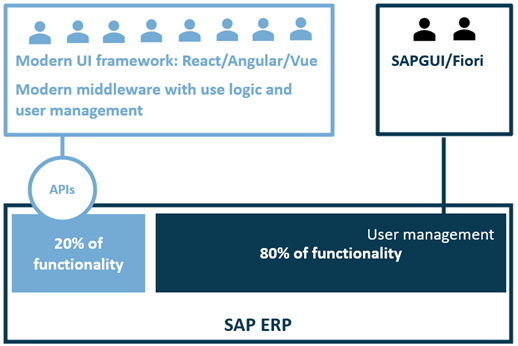Headless SAP might sound like a crazy term on its own, but I promise you it does make sense.
In this blog we’ll learn:
- What headless architecture is
- How it can significantly improve the SAP ERP user experience
- How it can make the transition to S/4HANA smoother
What is headless architecture?
The idea of headless architecture originates from e-commerce and web content management systems, and the basic idea is very simple: to decouple backend business logic from frontend user interfaces (UIs).
In headless architecture, the backend solution provides APIs instead of UIs and basically could be written without any UIs. Our other blog describes a practical guide for headless SAP architecture.

In the case of SAP ERP or S/4HANA, it makes sense that the UIs are provided by the back end. SAPGUI and Fiori UI are already available and are not going anywhere. Later we will learn how to apply headless architecture with SAP ERP and S/4HANA, and in the process create something that is beyond standard SAP.
Watch the video below to hear experts from SAP talking about headless architecture for SAP Commerce Cloud.
How does headless architecture improve the SAP user experience?
For many SAP ERP systems the 80:20 rule holds true – 80% of users use only 20% of the functionalities, while the remaining 20% use the majority (80%) of the functionalities.
Most users only need access to limited functionalities, such as those for warehouse operations, shop floor tasks, sales operations, or for entering working hours.

At the other end of the scale, there are a handful of super users who use several different functionalities and perform complex tasks using SAP.
Headless architecture should be used for the first group, i.e. the 80% who only need access to limited functionalities. The picture below illustrates the high-level architecture.

In this architecture:
- task-specific UIs are designed and implemented using React, Angular, or Vue
- the middleware layer should be containerized and include user management (including authentication and authorization)
- the middleware layer calls back-end APIs with technical user/connection
- APIs are purpose-built using ABAP code; however, standard function modules and BAPIs should be used when available
The middleware layer can run on a hyperscale platform like Microsoft Azure, Amazon Web Services, Google Cloud, or the SAP Business Technology Platform, all of which include plenty of tools to help develop this layer.
What are the key benefits of headless architecture?
- You can design modern, fit-for-purpose UIs and implement them independently from the back end
- APIs are often simple and quick to develop, and standard function modules or BAPIs can often be used as a starting point. This is because “headless” users do the same tasks as standard users but in a simpler way.
- A well-designed headless SAP architecture is quick, scalable, and secure, with less direct usage/users putting a strain on your business-critical backend and part of the load being taken by the hyperscale platform.
- SAP administration – especially roles, authorizations, and user management – becomes simpler because most user management is done in the middleware layer. A well-defined middleware layer will support your needs in a simple and secure way.
- A decoupled backend gives you more time to migrate to S/4HANA and means much less change management effort towards your end users – just keep your APIs as they are and let your headless users continue their work.
A smooth transition to S/4HANA
S/4HANA brings many improvements to SAP ERP, not least the ability to use Fiori UIs instead of SAP GUIs. However, it’s important to note that both the technical setup and user training for new Fiori UIs require a significant amount of work and can be challenging. In the worst case, you will need to modify SAP’s standard Fiori UIs or develop your own.
Headless architecture and modern UIs developed for your SAP ERP allow you to focus on new S/4HANA functionality and capabilities and improve your business processes. Relatively simple usage by the majority of your users means things should go very smoothly in your S/4HANA project. Basically, a few ABAPers just migrate your APIs from ERP to S/4HANA.
Summary
Headless architecture is a hot topic in digital commerce – an area that traditionally predicts future technology trends for more traditional IT systems like ERPs.
For those of us in the “traditional” ERP scene, this means we should:
- study headless architecture principles and technologies
- learn how to apply headless architecture in our own SAP ERP landscape
- develop a preliminary architecture and perform some trials, and then create a longer-term roadmap.
Got interested? Connect with me on LinkedIn!
Join the SAP GO community
Accelerate your transformation journey by joining the community and we'll keep you updated.
Join now!